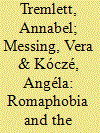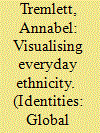| Srl | Item |
| 1 |
ID:
157074


|
|
|
|
|
| Summary/Abstract |
This special issue of Identities, entitled ‘Romaphobia and the media’, examines entrenched and ongoing media coverage of Roma, Gypsy and Traveller people across Europe. The focus is on how the media problematises the Roma, how it constructs a ‘conceptual map’ about Roma people and what this tells us about the societies we live in. This special issue includes five academic articles all examining the constructions and stereotypes used in the media in various formats and European countries. After these academic articles, this special issue then deviates from the normal journal structure by including three commentary pieces from professionals from varying Roma backgrounds to give their views and experiences on how they tackle Romaphobia and the media. The inclusion of these commentary pieces are very powerful in offering a perspective of active interventions and resistance that we should not forget amidst the depressing continued circulation of racialised stereotypes.
|
|
|
|
|
|
|
|
|
|
|
|
|
|
|
|
| 2 |
ID:
157079


|
|
|
|
|
| Summary/Abstract |
The visual image of Roma people in the media is mired in racialised notions of ‘the other’. Whilst we know what Roma stereotypes look like, there is little clarity as to how a ‘non-stereotypical’ image might be constructed. In order to examine the non-stereotypical, two sources of images are analysed: (1) entrants from an anti-stereotype Roma photography competition and (2) self-representations produced by Roma participants during ethnographic research. The findings show that if ‘Roma’ is foregrounded as the subject, even a non-stereotypical approach can reproduce ‘difference’ (from a supposed ‘norm’). ‘Roma’ is thus, at the moment, still strongly linked to a notion of ethnicity that is seen as different and racialised. However, when ethnicity is not emphasised, but rather self-representations and the ‘everyday’, such orthodoxies are challenged. These sources provide a unique opportunity to create a deeper understanding of ‘non-stereotypical’ images in order to challenge misrepresentations and racism.
|
|
|
|
|
|
|
|
|
|
|
|
|
|
|
|